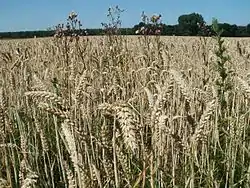kvieši
Latvian

Kvieši
Etymology
From an earlier *kvietis (plural kvieši, genitive *kvietya > kvieša, from which a new singular kviesis was formed by analogy), from Proto-Baltic *kʷiet-, from Proto-Indo-European *kʷeyt- (“to shine; bright; white”), from a stem *kew-, *ḱew- (“to shine; bright”) with an extra -t. The original meaning was probably “light, bright one” > “wheat,” given its color. Cognates include Lithuanian kviečiaĩ, singular kvietỹs, Proto-Germanic *hwaitijaz (Old Norse hveiti, Norwegian kveite, Old High German weizi, German Weizen, Old English hwæte, English wheat).[1]
Pronunciation
- IPA(key): [kvìɛʃi]
| (file) |
Noun
kvieši m (2nd declension)
- wheat (esp. Triticum aestivum)
- kviešu milti ― wheat flour
- kviešu maize ― wheat bread
- kviešu lauks ― wheat field
- sēt kviešus ― to sow wheat
- pļaut kviešus ― to mow wheat
Usage notes
There is a singular form kviesis, only sporadically attested (usually to refer to the plant). There is also a family name Kviesis.
Declension
Declension of kvieši (2nd declension)
| singular (vienskaitlis) | plural (daudzskaitlis) | |
|---|---|---|
| nominative (nominatīvs) | — | kvieši |
| accusative (akuzatīvs) | — | kviešus |
| genitive (ģenitīvs) | — | kviešu |
| dative (datīvs) | — | kviešiem |
| instrumental (instrumentālis) | — | kviešiem |
| locative (lokatīvs) | — | kviešos |
| vocative (vokatīvs) | — | kvieši |
References
- Karulis, Konstantīns (1992) “kvieši”, in Latviešu Etimoloģijas Vārdnīca (in Latvian), Rīga: AVOTS, →ISBN
This article is issued from Wiktionary. The text is licensed under Creative Commons - Attribution - Sharealike. Additional terms may apply for the media files.